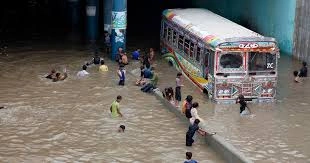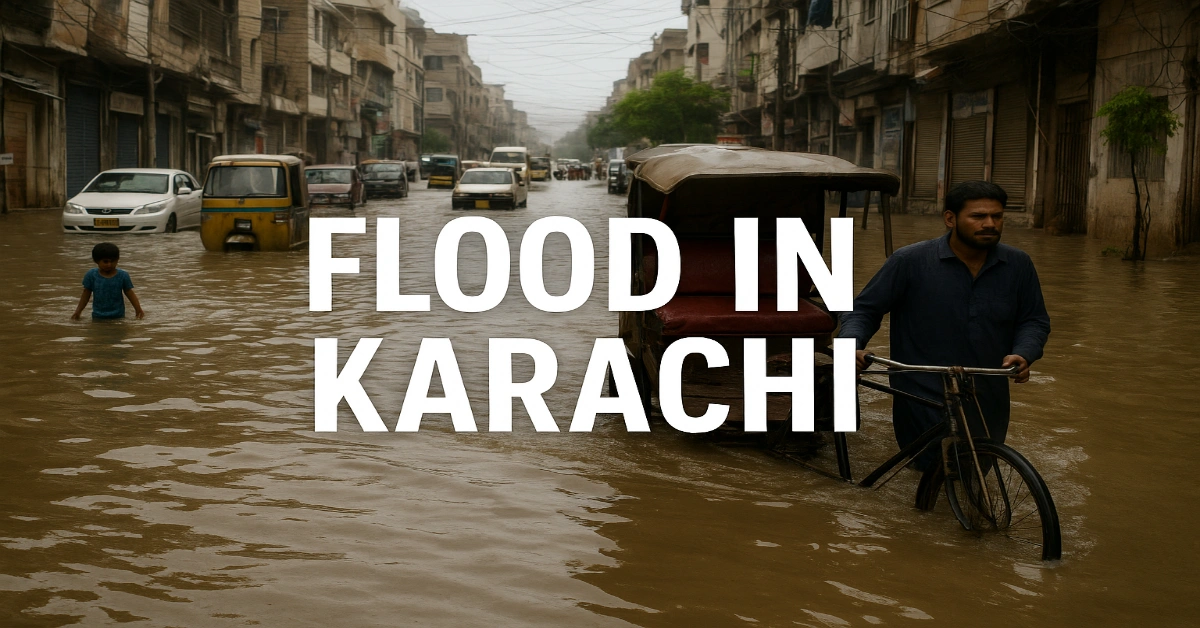Get the latest updates on flood in Karachi conditions, safety advice, and relief efforts. Stay prepared and protect your loved ones during the flood in Karachi season with trusted guidance. The flood in Karachi not only damages property but also disrupts normal life for weeks. To handle this situation, people need awareness, safety tips, and timely support.
Introduction: Understanding Karachi’s Flooding Crisis
The flood in Karachi is one of the biggest problems the city faces every monsoon. Heavy rains, poor drainage, and unplanned growth turn streets into rivers, causing traffic jams, power failures, health risks, and damage to homes. The flood in Karachi is not only about heavy rain but also about weak planning and lack of public awareness. With stronger drainage systems, quick government action, and active community support, the impact of flood in Karachi can be reduced, protecting both lives and property in the city.
Geography and Urbanization: Why Karachi Is Prone to Flooding
Karachi is naturally low-lying, with many areas close to the sea. During heavy rains, water cannot drain easily, leading to quick flooding. Rapid urbanization has made the problem worse. Open land that once absorbed rain is now covered with roads, buildings, and concrete. Poor drainage systems, blocked nullahs, and unplanned housing further trap water inside the city. Because of this mix of geography and fast urban growth, Karachi faces repeated flooding every monsoon season. To reduce the impact, the city needs better planning, improved drainage, and careful management of new construction projects
Climate Change and Shifting Monsoon Patterns
Climate Change and Shifting Monsoon Patterns are creating serious problems across South Asia. In recent years, rains have become heavier, unpredictable, and longer than before. Cities like Karachi face sudden downpours that drainage systems cannot handle, leading to floods and health risks. Farmers also struggle because changing monsoon timings affect crops and water supply. These shifts are linked to rising global temperatures, deforestation, and poor urban planning. To reduce damage, experts suggest building stronger drainage, planting more trees, and spreading awareness. Understanding these changes is the first step toward protecting people, homes, and the environment.
From SAMAA TV:https://www.youtube.com/@Samaatv
The Role of Poor Infrastructure and Drainage Systems
The role of poor infrastructure and drainage systems is a major cause of Karachi floods. Narrow drains, broken pipelines, and unplanned roads block the flow of rainwater. Garbage in nullahs makes the situation worse, turning heavy rain into Karachi floods that damage homes, markets, and transport. When drainage fails, the city cannot handle even normal rainfall. Without strong planning, Karachi floods will continue to disrupt daily life. To solve this problem, regular cleaning of drains, better road design, and modern infrastructure are needed to reduce risks and protect people from future disasters.
Also Read:5.1 Earthquake – 75 km south of Fayzabad-Get More Details!
Historical Overview: Major Flood Events in Karachi
Karachi has faced several major floods over the years, mainly due to heavy monsoon rains and poor drainage. The 1977 flood was one of the first big disasters, followed by severe floods in 2007, 2009, and 2010. In 2020, record-breaking rains caused one of the worst floods in Karachi’s history, damaging homes, roads, and businesses. These major flood events show how unplanned growth and weak infrastructure keep Karachi at high risk every monsoon season
Daily Disruptions: Impact on Transportation, Health, and Living Conditions
Floods in Karachi bring daily disruptions that affect almost every part of life. Roads get blocked with water, making transport slow and unsafe. People struggle to reach offices, schools, or hospitals, and traffic jams waste hours every day. Stagnant water spreads diseases like dengue, malaria, and stomach infections, putting public health at serious risk. At the same time, many families face power cuts, lack of clean drinking water, and damage to homes, which makes daily living very difficult. These problems show how floods directly disturb transportation, health, and living conditions, turning normal city life into a constant struggle.
Economic Impact of Frequent Flooding
The economic impact of frequent flooding in Karachi is very serious and long-lasting. During Karachi floods, businesses close for days, transport stops, and industries face huge losses due to power cuts and damaged supply chains. Shops, warehouses, and markets lose goods worth millions, while workers cannot reach offices, causing income loss. Families also suffer as homes, furniture, and valuables are destroyed, adding extra financial stress. The government spends billions on road repairs, drainage, and emergency relief after every flood. Repeated Karachi floods not only damage property but also slow down the city’s overall economy and reduce investor confidence, keeping Karachi at risk every monsoon season.
Government Response and Emergency Preparedness
The government response and emergency preparedness during Karachi floods has often been reactive instead of preventive. Authorities usually start rescue operations, clear blocked roads, and set up relief camps only after heavy damage has already happened. While these steps give short-term support, they do not solve the bigger issues. To handle Karachi floods better, the government needs strong planning, including upgraded drainage systems, trained rescue teams, and reliable early warning systems. Without proper emergency preparedness, Karachi floods will continue to cause major losses every monsoon season.
Community Resilience: Local Initiatives and NGO Efforts
The strength of Karachi’s people can be seen through community resilience: local initiatives and NGO efforts during floods. When government support is slow, local groups and volunteers step in to provide food, clean water, and shelter to affected families. Many NGOs also run medical camps, distribute relief goods, and help rebuild damaged homes. At the same time, community-based efforts like neighborhood cleaning drives, volunteer rescue teams, and awareness campaigns play a big role in reducing risks. These local initiatives and NGO efforts not only give quick help during emergencies but also build long-term resilience by teaching people how to stay safe and support each other during disasters.
The Road Ahead: Long-Term Solutions and a Flood-Resilient Karachi
To fight the damage of Karachi floods, the city needs strong drainage systems, better waste control, and smart urban planning. Public–private efforts, awareness programs, and strict action against illegal construction are key to reducing risks. With the right steps, a flood-resilient Karachi can be built, where people are safer from future Karachi floods and daily life is not disrupted every monsoon.





Join The Discussion